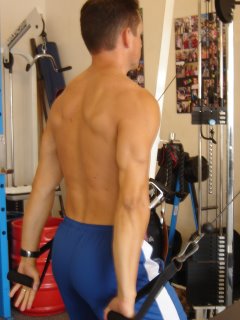Intelligent Quote of the Month:
"To me, the sign of a really excellent routine is one which places great demands on the athlete, yet produces progressive long-term improvement without soreness, injury or the athlete ever feeling thoroughly depleted. Any fool can create a program that is so demanding that it would virtually kill the toughest marine or hardiest of elite athletes, but not any fool can create a tough program that produces progress without unnecessary pain."
Dr. Mel C. Siff
This quote is great. My twin brother Keats recently put it in his excellent newsletter. If you have not signed up for his newsletter, you can do so at
www.keatssnideman.comI agree with the late Mel Siff. How easy it is to design a program that can easily SMOKE somebody. But how difficult is to design a program that get someone super strong yet with no injuries. Something to think about, espeically me with my back issues.
Disc Injuries -
The majority of disc injuries are caused by repeated flexion with rotation. I'm not sure this was my reason for injury, although with heavy deadlifts (which is what injured my spine this time)I know I lose lumbar lordosis. However the majority of disc disorders are caused by poor habits and lazy postures. I wouldn't consider my posture to be lazy, although I have established some poor work habits while working with my clients. Flexing my lumbar spine while doing bodywork, picking up dumbbells and weight plates with a flexed spine. Done once or twice is not a big deal, but done repeatedly day after day for years will destroy the integrity of the disc. I'm convinced that 95% or more of back injuries are result of bad lifting and postural habits. These injuries can be prevented with correct postural exercises and changing habitual movement patterns.
Spinal Instability -
Tissue is damaged from joint laxity, and joint laxity leads to instability. With decreased disc height comes ligament laxity which causes this instability. So when people injure their backs they often feel that there back is too tight, which is often a total fallacy. These same people will try to "stretch" out their pain and this often makes their condition worse. I have experienced this in my own body. The more I stretch my lumbar spine, the more I hurt. If I do too much Joint mobility, Z-heatlh, etc..., I hurt. Most people need more stiffness in thier lumbar spine, not less, especially if they are lifting weight and playing sports. The older I get the more I benefit from stability exercises in the lumbar area where the focus is maintaining a neutral spine.
Much more to come on this topic.......







